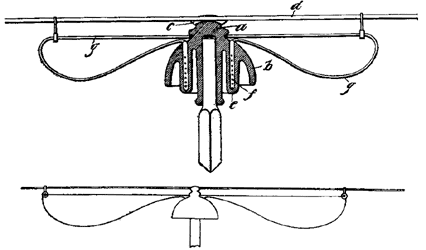[Trade Journal]
Publication: Electrical World and Engineer
New York, NY, United States
vol. 36, no. 12, p. 452, col. 2
High Voltage Heated Insulator.
A patent has been granted to Mr. A. Sinding Larsen, of Frederiksvaern, Norway, on a new form of heated high-voltage insulator. The insulators for this purpose are generally made out of insulating material and formed with hoods or bell-shaped flanges, the purpose of which is to prevent moisture from forming a continuous conducting film or connection between the metallic conductor and the post or bracket carrying the insulator. It is known, however, that whatever form such insulator is given it is not possible to prevent the condensation of moisture unless special means are employed; and the object is to provide means for preventing such condensation on a part of the insulator to break the conducting surface or film.
The invention consists in combining with the insulator means for heating it so that a part of the insulator will always have a little higher temperature than the rest. The difference in temperature need not be very great, and only one degree Centigrade proves to be sufficient, because the moisture in the air surrounding the insulator will always condense on that part of the insulator that has the lowest temperature, notwithstanding the fact that the heated part may have a temperature low enough to condense the moisture. The moisture, so to speak, avoids the warmer one of two cold surfaces and only the colder one acts as a condenser. This heating of a part of the insulator may be performed by means of an electric current passing through a resistance enclosed in the insulator. For this purpose a very weak current is sufficient, about one-tenth of a watt under ordinary circumstances.
In the accompanying drawings Fig. 1 shows a vertical central section through the insulator. Fig. 2 shows in elevation an insulator, the conductor, and means for obtaining a current from the same to heat the insulator. In Fig. 1 a is the body of the insulator, having, as usual, a hood b and a slotted top c, in which the conductor d rests and to which it may be tied; e is an internal depending flange having an annular pocket in which a resistance coil f is embedded in an insulating material. This resistance coil or other resistance is connected to a separate conductor g, suspended, if desired, from the main line.
 |
| Figs. 1 and 2. - Heated Insulator. |
Instead of having a separate conductor along the line for the heating circuit, this latter may be arranged as a local induction circuit at each insulator, taking current by induction from the main conductor, as illustrated, in which case the main line carries an alternating or pulsating current, or the heating current may be taken from the main line in any other suitable manner. Mr. Larsen shows, as an example of construction, a local wire g, connected to the heater f in the insulator and suspended and insulated from the main conductor d, which carries the alternating or pulsating current. By this arrangement a current will be induced in the secondary local circuit of sufficient strength to heat the coil f on the insulator. By the means shown the inner flange e will be given a higher temperature than the hood b, and the former will therefore remain dry and free from moisture, forming in this manner an insulating zone between the hood and the supporting part of the insulator.
